May 17, 2025 | 10:11 GMT +7
May 17, 2025 | 10:11 GMT +7
Hotline: 0913.378.918
May 17, 2025 | 10:11 GMT +7
Hotline: 0913.378.918
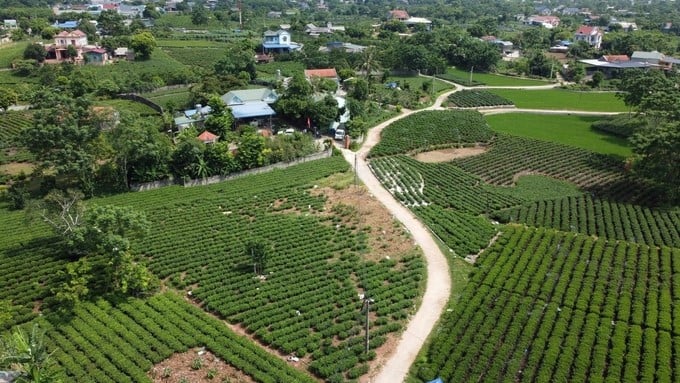
Tan Cuong Commune, the "first famous tea" land. Photo: Toan Nguyen.
A quiet, peaceful countryside right next to the city that is famous for industry. It is a suburb of Thai Nguyen city, at the eastern foot of the Tam Dao range.
"Thai tea, Tuyen girl"—no one knows when that conclusion appeared. From ancient times, Thai Nguyen was a land with many famous tea-growing place names, such as Trai Cai tea, Minh Lap in Dong Hy district, La Bang tea in Dai Tu district, Tuc Tranh tea, Vo Tranh in Phu Luong district, etc. However, when it comes to Thai tea, almost everyone immediately thinks of Tan Cuong, and the title of “first famous tea” also originates from this land.
It is a suburb of Thai Nguyen City, at the eastern foot of the Tam Dao range. The Cong river, which originates from the top of Ba La mountain in Dinh Hoa and flows here, has been conquered by humans and turned into a large Nui Coc lake with the legendary love story of a man named Coc and a girl named Cong. Below the mountain lake, a half-mountain, half-plain area with bowl-shaped hills in succession belongs to the administrative territory of six communes: Tan Cuong, Phuc Xuan, Phuc Triu, Thinh Duc, Quyet Thang, and Phuc Ha. Thai Nguyen people refer to this area as tea land, which is also the geographical indication area of Tan Cuong tea.
Blue as far as the eye can see. In the early morning or sunset moments, when the sun shines down, standing on the tea hills of Tan Cuong and watching the rays of sunlight sparkle through the green of the forest, river, and vast tea fields will give you a full sense of the fairytale’s beauty. This fairytale is set in a quiet, peaceful countryside right next to a city that is famous for industry. That's why there is a poem as follows: "The sweetness permeates from the earth; the fragrance filters the air; he comes to Thai Nguyen to enjoy the festival; the tea water is on the lips.”
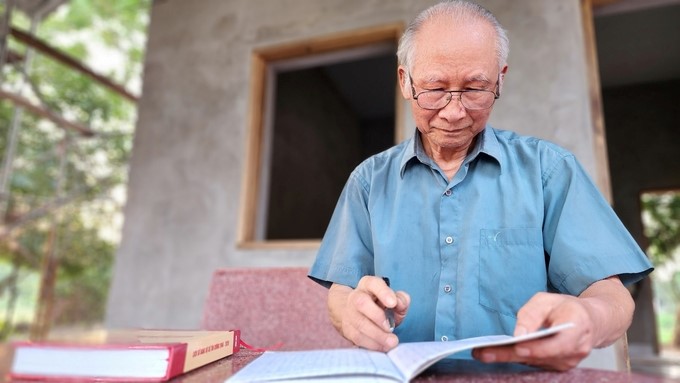
Meritorious teacher Nguyen Dinh Dai. Photo: Van Viet.
At the age of 80, meritorious teacher Nguyen Dinh Dai is still very perspicacious, with ruddy skin, a hale and hearty appearance, keen ears and eyes, and a super-ordinary memory. The people of the tea land often call Mr. Dai a teacher. If someone wants to know about this land and discover the "first famous tea" but has not met Mr. Dai, it is as if they do not know anything. The old man said that every day he still carried a hoe to dig a hole to plant tea, and in his spare time, he groped to study the history of the Tan Cuong land and people. On the annual Spring Tea Festival of the tea land, the old man is still in a stable position in the jury to assess good tea and bad tea. The secret shared for the understanding of Tan Cuong tea is thanks to being addicted to this tea since childhood. Previously, when he was teaching in Ham Yen, also a famous tea area in Tuyen Quang, every month, the teacher Dai still had to go back to his hometown to bring home tea to drink. If he cannot come back in a month, it's like seeing his body different from usual, as if it wants to get sick.
The teacher’s origin is in Chem village, Hanoi. His grandfather was a soldier of the French era who was captured to fight in World War I. After fortunately coming back alive, dozens of soldiers were granted reclamation land by the protection authority to establish an emigration hamlet, of which 11 went to Tan Cuong land. They can be considered the first people to explore this land.
When teacher Dai had just retired from teaching, he had been invited by the commune to participate in the construction of the history book of the Tan Cuong Party Committee. Only after researching can it be found out that this place used to be just a jungle; at the end of the 18th century, the French established two large plantations in this place but later abandoned them. Tan Cuong used to only have a few households of the Ngai ethnic group living next to the banks of the Cong River and Da stream, somewhere in the middle of the old forest. The soldiers set foot here, then went back to their hometown to recruit people from the plains to create the world. Gradually forming villages and communes. The history book of the Tan Cuong Party Committee compiled by teacher Dai recorded that today’s Tan Cuong people come from 17 provinces, mainly in the plains, such as Hung Yen, Nam Dinh, Thai Binh, Ha Nam, etc.
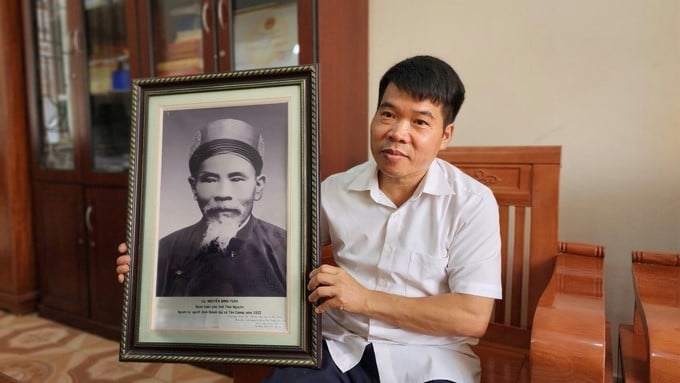
Secretary of the Party Committee, Chairman of the Tan Cuong People's Committee, with a photo of Mr. Nguyen Dinh Tuan. Photo: Hoang Anh.
Teacher Dai slowly said that if talking about famous tea, it must be said from that time when the land is a hundred years old and the profession of tea is also a hundred years old. Those who pay attention will see that most of the cooperatives and tea business households in Tan Cuong today take the crane-shaped tea top symbol, which is a way to remember the merits of the provincial chief, Mr. Nguyen Dinh Tuan, and Mr. Doi Nam Vu Van Hiet. These two people are likened to the tutelary gods of Tan Cuong commune and the ancestors of the tea industry. One founded Tan Cuong commune; the other had the merit of bringing tea varieties from Thanh Ba and Phu Tho to grow, turning this place into the hometown of the "first famous Tan Cuong tea" later.
In the years 1925–1926, the provincial chief Nguyen Dinh Tuan decided to establish Tan Cuong commune. A new and vast land, but it is difficult to think of what is suitable for plantation. The provincial chief and Mr. Doi Nam heard that the lives of people in Phu Tho were quite good when they relied on tea, so the two people discussed going there to ask for seeds to plant.
At first, only a few households tried to grow it, but they did not expect the midland tree. From a midland tree variety that was not so famous in the past, it developed as if it had turned into a dragon when it was grown in Tan Cuong land. The sites of Tan Cuong today, such as Guoc, Soi Vang, and Hong Thai hamlets, etc., are all traces of the Tan Cuong tea tree. Gradually, it spread to Phuc Xuan and Phuc Triu communes and then became a commodity that was not only famous in all regions at that time but also sold to China, Europe, India, etc.

The current midland tea variety in Tan Cuong. Photo: Van Viet.
In 1935, the French held a tournament in Hanoi, near Hang Co station. There were hundreds of tea kinds from all regions brought there to compete, but none of them could surpass Tan Cuong tea. After that competition, Mr. Doi Nam's brand of crane-shaped tea flew further and further, and international customers came to Tan Cuong to order. Thereby the world knew that Thai Nguyen had a very good tea area, and the title of “first famous tea” seems to have existed since that time.
Households grow tea, and people make tea. The family of teacher Dai has been making tea for four generations. The teacher, after half a life of wandering for teaching, finally returned to the tea garden. During the years of subsidies, with the concept "First Farmers, Second Intellectuals," most of the teachers were thus starving. Without this tea garden, the teacher's family would know where to cling.
"Tan Cuong should have a place to worship Mr. Tuan and Mr. Hiet, both to remember their merits and pass them on to the next generations. Unfortunately, we have petitioned many times but have not yet accepted," said Mr. Dai.
Translated by Huyen Vu Thu
/2025/05/16/3800-0-nongnghiep-143756.jpg)
(VAN) Suntory PepsiCo Vietnam coordinated with the Ministry of Education and Training to implement an education program on water conservation, reaching nearly 1 million primary school students nationwide.
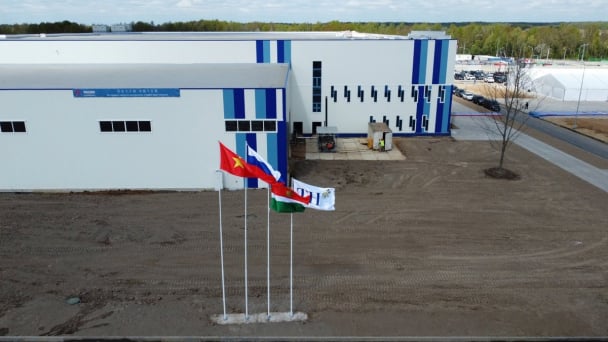
(VAN) Vietnam’s TH Group officially put its high-tech fresh milk processing plant into operation in the Russian Federation, marking a historic moment as the first TH true MILK cartons were produced in Russia.

(VAN) Use of high-quality broodstock and biotechnology is regarded as the most effective approach to ensuring sustainable and economically viable shrimp aquaculture ahead of climate change and the emergence of increasingly intricate disease patterns.
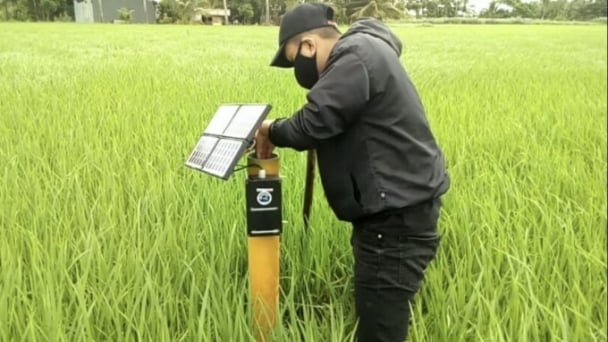
(VAN) Carbon farming is a form of agricultural practices that helps absorb more greenhouse gases than it emits, through smart management of soil, crops, and livestock.

(VAN) This is a key content of the Memorandum of Understanding recently signed between the Vietnam Fisheries Society and Kunihiro Inc of Japan.
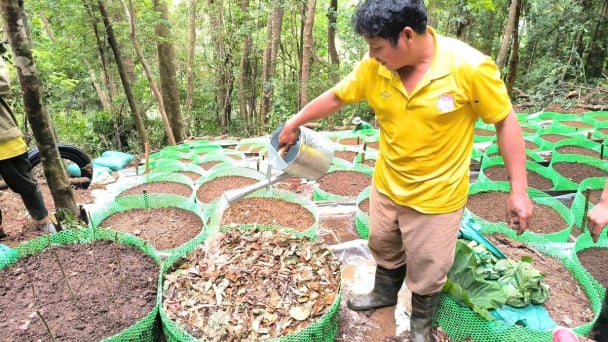
(VAN) To achieve the goal, local authorities and businesses in Kon Tum province have fully prepared the necessary conditions for the new Ngoc Linh ginseng planting season.
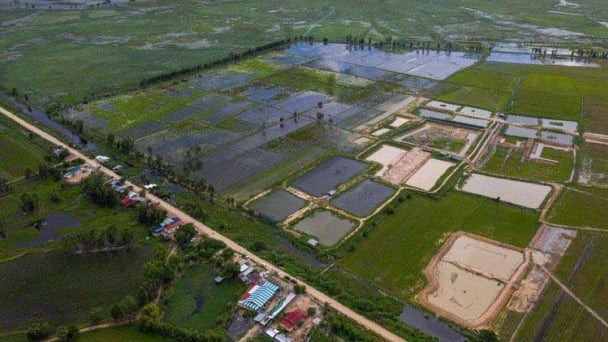
(VAN) Jiangsu province is gearing up to host training programs in Phnom Penh, the capital of Cambodia, this year to establish the Fish and Rice Corridor.